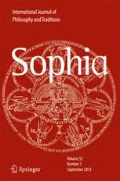Abstract
In this journal, Einar Bøhn has proposed a solution to the so-called Trinitarian Paradox. After summarizing the Paradox and Bøhn’s proposed solution, I argue that those committed to Christian orthodoxy cannot accept the solution, for three reasons: First, it requires positing more kinds of divine entity than God and the Persons of the Trinity; second, it is based upon a false assumption; and, finally, the proposed solution amounts at best to a form of obscurantism.
Notes
The order in which I present the parts is reversed from how Bøhn presents them.
This example is drawn from Baxter (1988a).
The term is not original to Bøhn. For example, Lewis (1991) uses the same term when discussing composition as identity.
Let ‘X,’ ‘Y,’ and ‘Z’ range over both proper and improper pluralities (Cf. Sider 2007).
Bøhn’s examples are that of a human body, on the hand, and the head, torso, arms, and legs that compose the body, on the other hand and that of a pair of shoes, on the one hand, and the two individual shoes that we might say “compose” the pair, on the other hand. See Bøhn (2011, 265).
As indicated by the quote above, Bøhn speaks in terms of “conceptualizing” things. I am assuming that to conceptualize something is to apply a concept to that thing.
By ‘mind-independent,’ I mean independent of minds other than God’s. Also, Bøhn himself appeals to the ‘naturalness’ of concepts and the ‘fundamentality’ of properties in order to fend off the claim that his solution implies theological constructivism (2011, 372). In another context, Bøhn explicitly states that he follows Frege in claiming that concepts are objective things that exist mind-independently (Bøhn 2014, 147; cf. Frege 1884 [1953]). For my purposes, we can set aside the plausibility of these two moves by Bohn. For, they at least require claiming that the cardinality of a portion of reality depends upon some mind-independent feature of the world, which is all that my argument needs.
Cotnoir (2013), who defends a similar view, makes essentially the same point.
References
Baxter, D. (1988a). Identity in the loose and popular sense. Mind, 9, 575–582.
Baxter, D. (1988b). Many-one identity. Philosophical Papers, 17, 193–216.
Bøhn, E. (2011). The logic of the Trinity. Sophia, 50, 363–374.
Bøhn, E. (2014). Unrestricted composition as identity. In A. Cotnoir & D. Baxter (Eds.), Composition as identity. Oxford: Oxford University Press.
Cotnoir, A. (2013). Composition as general identity. In K. Bennett & D. Zimmerman (Eds.), Oxford studies in metaphysics (Vol. 8). Oxford: Oxford University Press.
Frege, G. (1884 [1953]). The foundations of Arithmetic. Translated by J. Austin. New York: Harper & Brothers.
Lewis, D. (1991). Parts of classes. Oxford: Basil Blackwell.
Sider, T. (2007). Parthood. Philosophical Review, 116, 51–91.
Acknowledgements
I would like to thank the anonymous referee for reading this essay and providing helpful feedback.
Author information
Authors and Affiliations
Corresponding author
Additional information
Publisher’s Note
Springer Nature remains neutral with regard to jurisdictional claims in published maps and institutional affiliations.
Rights and permissions
About this article
Cite this article
Long, J. Mystery of the Trinity: a Reply to Einar Bøhn. SOPHIA 58, 301–307 (2019). https://doi.org/10.1007/s11841-019-0710-0
Published:
Issue Date:
DOI: https://doi.org/10.1007/s11841-019-0710-0

